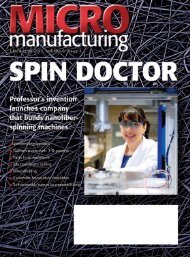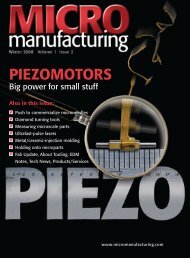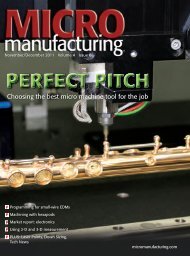to view as PDF - MICROmanufacturing
to view as PDF - MICROmanufacturing
to view as PDF - MICROmanufacturing
Create successful ePaper yourself
Turn your PDF publications into a flip-book with our unique Google optimized e-Paper software.
MEASUREMENT matters<br />
Video me<strong>as</strong>urement: lights, camera—progress<br />
16 | MAY/JUNE 2012 | <strong>MICROmanufacturing</strong><br />
Having been in the manufacturing<br />
industry for almost 20 years, specializing<br />
in metrology, I have seen many changes<br />
in video-me<strong>as</strong>urement systems. The technology<br />
h<strong>as</strong> made great strides in recent years.<br />
The addition of new system features h<strong>as</strong><br />
changed how inspection personnel capture,<br />
display and use images.<br />
When I first joined the industry, videome<strong>as</strong>urement<br />
units (VMUs) ran on the<br />
DOS operating system and system lighting<br />
left much <strong>to</strong> be desired. Today, the systems<br />
incorporate much better camer<strong>as</strong>, run on the<br />
latest Windows operating systems and offer<br />
LED-b<strong>as</strong>ed lighting that is controllable and<br />
repeatable.<br />
Brighter picture <strong>to</strong>day<br />
Comparing <strong>to</strong>day’s VMUs with their<br />
predecessors, the most noticeable difference<br />
is image size and clarity of the display.<br />
All images: Scienscope<br />
Out with the old, in with the new. Video<br />
me<strong>as</strong>urement began with units such <strong>as</strong> the one<br />
at right with 9" moni<strong>to</strong>rs, metrology boxes and<br />
black-and-white camer<strong>as</strong>. Modern VMUs (left)<br />
come with <strong>to</strong>uch screens, large moni<strong>to</strong>rs and<br />
sophisticated software that improves accuracy and<br />
e<strong>as</strong>e of use.<br />
Digital camer<strong>as</strong> that offer vibrant and bold<br />
four-color images have replaced outdated<br />
black-and-white camer<strong>as</strong>. Where once 9"<br />
moni<strong>to</strong>rs were the largest that could be used,<br />
<strong>to</strong>day the only limit <strong>to</strong> moni<strong>to</strong>r size is the<br />
workspace available for it.<br />
Camer<strong>as</strong> of the p<strong>as</strong>t had many weaknesses,<br />
the biggest being the connec<strong>to</strong>r.<br />
BNC (bayonet-style) connec<strong>to</strong>rs offered only<br />
a mono signal. Then came RCA (phono)<br />
connec<strong>to</strong>rs, where the image w<strong>as</strong> split, then<br />
put back <strong>to</strong>gether. (Something w<strong>as</strong> always<br />
lost in translation with these connec<strong>to</strong>rs.)<br />
Today, USB connec<strong>to</strong>rs enable a direct<br />
connection from the camera <strong>to</strong> the computer.<br />
The downside <strong>to</strong> USB connec<strong>to</strong>rs is the<br />
refresh rate isn’t <strong>as</strong> f<strong>as</strong>t <strong>as</strong> when using highdefinition<br />
multimedia interface (HDMI)<br />
connec<strong>to</strong>rs, and neither is the clarity.<br />
The next generation of video-me<strong>as</strong>urement<br />
machines will offer full HD images.<br />
Using an HDMI connec<strong>to</strong>r, the user will<br />
be able <strong>to</strong> transfer images directly from the<br />
camera <strong>to</strong> a “frame grabber” card on the<br />
me<strong>as</strong>urement machine, allowing for the<br />
clearest possible digital image <strong>to</strong> be displayed.<br />
This will allow parts on the screen <strong>to</strong> be<br />
seen <strong>as</strong> clearly <strong>as</strong> the images from a Blu-ray<br />
disc player in a home theater system, and<br />
will prove particularly advantageous for<br />
inspecting microparts that might otherwise<br />
be difficult <strong>to</strong> see.<br />
Incre<strong>as</strong>ingly powerful computers and<br />
moni<strong>to</strong>rs are now more affordable, which<br />
h<strong>as</strong> led <strong>to</strong> major improvements in videome<strong>as</strong>urement<br />
equipment. New systems have<br />
<strong>to</strong>uch screens. There are edge-detection<br />
<strong>to</strong>ols available that find features—and allow<br />
users <strong>to</strong> me<strong>as</strong>ure them just by sliding a finger<br />
across the screen. Also, users can choose a<br />
one-but<strong>to</strong>n <strong>to</strong>ol that allows them <strong>to</strong> me<strong>as</strong>ure<br />
the contents of a circle on the screen.<br />
The ability <strong>to</strong> me<strong>as</strong>ure parts accurately on<br />
the display is a major innovation. With older<br />
VMUs, a model of the part would be built in<br />
a separate, geometric screen, where features<br />
such <strong>as</strong> hole-<strong>to</strong>-hole locations, angles and<br />
distances would be me<strong>as</strong>ured. In on-display<br />
me<strong>as</strong>urement, all the me<strong>as</strong>urements are<br />
listed right on the picture of the part. This is<br />
a useful feature because the picture can be















